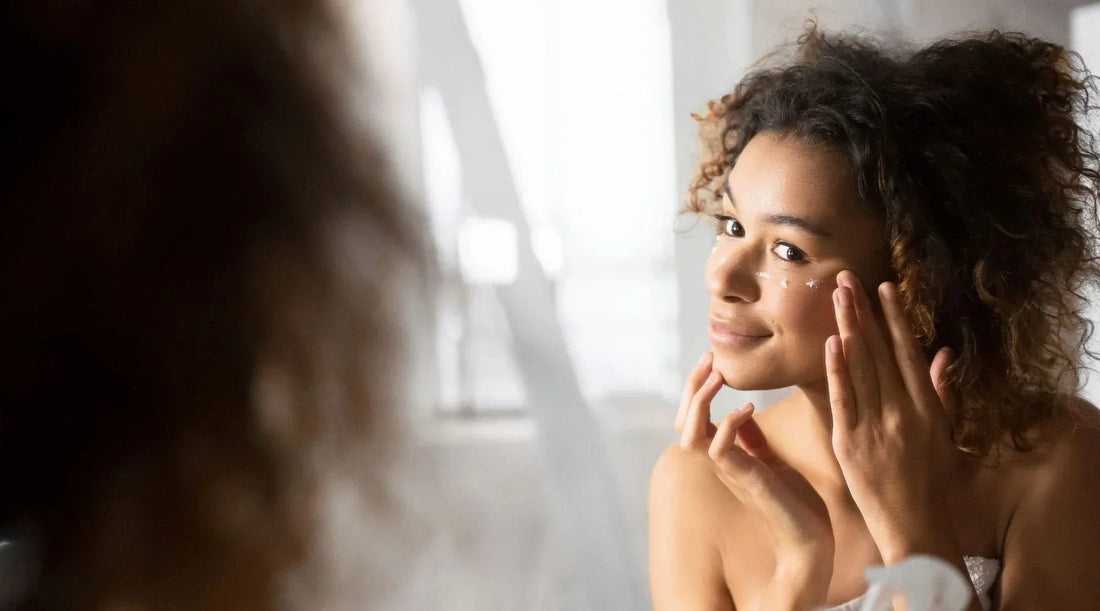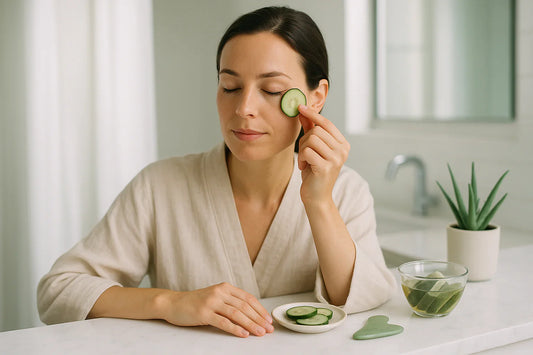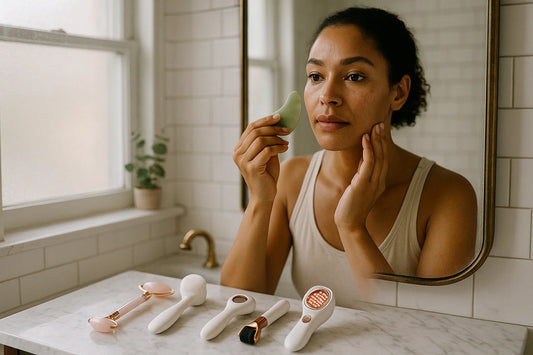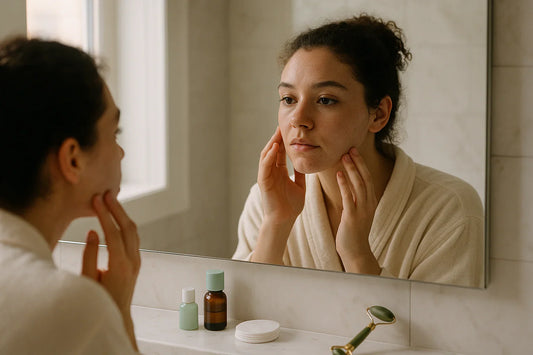Get your package anywhere!

Eye Cream or Serum First? The Ultimate Product Layering Guide
Did you know that more than 70% of skincare users apply their products in the wrong order—potentially wasting active ingredients and money? Mastering the sequence of serum and eye cream is essential for glowing, healthy skin. Here's everything you need to know about product layering, backed by dermatology research.
Table of Contents
- Understanding Skincare Product Layering
- The Science Behind Eye Creams and Serums
- Correct Order of Application
- Application Techniques
- Common Mistakes to Avoid
- Myths & Facts About Eye Cream and Serum Order
- FAQ
- Conclusion
Understanding Skincare Product Layering
Think of your routine like layering a perfect sandwich—order matters for taste and structure. In skincare, it’s about letting the most penetrating formulas work first. The trusted thin-to-thick rule maximizes ingredient absorption and efficacy. Lighter products (like serums) go on clean skin so they don’t have to “fight through” heavier layers.
According to Dermatology Times, water-based layers absorb fastest, while creams and oils provide protective barriers and lock in actives. That’s why waiting 30–60 seconds between steps is key for results.
“Proper order and absorption time ensures your active ingredients actually reach the skin rather than sitting inactive on top. This is vital for anti-aging and treatment results.”
| Product Type | Absorption Rate | Layering Order |
|---|---|---|
| Serum (water-based) | Fastest | First |
| Eye Cream (emollient) | Slower | After serum |
| Oil/Balm | Slowest | Last |
The Science Behind Eye Creams and Serums
Eye creams are thicker, more occlusive, and loaded with gentle ingredients like peptides and ceramides, ideal for the fragile under-eye area. They seal in moisture, reduce fine lines, and protect delicate skin.
Serums are the high-performing actives—light, concentrated, and designed to carry smaller molecules deep into the skin. As detailed in the Journal of Dermatological Science, serums’ molecular size enables impactful results, particularly for aging, dullness, and discoloration.
“Switching to serum first, then eye cream, seriously improved my results. My under-eye area has never looked so hydrated—makeup sits better, too!”
— Jordan, HighWand Customer
| Attribute | Serum | Eye Cream |
|---|---|---|
| Texture | Lightweight | Rich, creamy |
| Molecular Size | Small | Large |
| Primary Benefit | Penetrates, treats | Protects, hydrates |
Correct Order of Application
Here’s the golden rule: Serum always goes before eye cream. This allows actives to absorb fully before richer creams are applied. The only exception is if your “serum” is oil-based (rare)—in that case, adjust accordingly.
- Apply serum to clean, dry skin
- Wait 30–60 seconds
- Gently apply eye cream around orbital bone
- Allow another minute before moisturizer or SPF
Patience pays off: letting each layer sink in can make a visible difference in skin plumpness and makeup longevity.
Application Techniques
Technique matters! For serums, use 2–3 drops, pressing into skin with your palms—no harsh rubbing needed. Wait for it to absorb. For eye cream, tap a pea-sized amount using your ring finger (gentlest pressure) around the orbital bone, not too close to the lashes.
Apply morning and night unless actives (like retinol) increase sensitivity. And remember—less is more!
Common Mistakes to Avoid
- Layering products without waiting for each to absorb (causes pilling and poor performance)
- Using too much product—wastes funds and increases risk of irritation
- Applying water-based serum over an oil—creates a barrier and blocks absorption
- Neglecting the under-eye area completely or using facial actives too close to the eyes
Myths & Facts About Eye Cream and Serum Order
-
Myth: You can mix eye cream and serum together.
Fact: Mixing dilutes effectiveness; layer for optimal results. -
Myth: Eye cream must always go before serum.
Fact: Serum first, then eye cream is best for absorption—except for oil-based serums. -
Myth: More product means faster results.
Fact: “More” can lead to clogged pores and irritation—pea-sized amounts are plenty! -
Myth: If you apply products quickly, it's just as effective.
Fact: Allowing absorb time boosts visible results and prevents pilling.
FAQ
Can I mix eye cream and serum together?
No. Mixing can dilute key ingredients. Always layer: serum first, then eye cream.
How long should I wait between applying serum and eye cream?
Wait 30–60 seconds for best absorption before layering the next product.
Should I apply eye cream before or after moisturizer?
After serum and before moisturizer is best. Eye creams are usually lighter than most moisturizers.
Can I use eye cream and serum twice daily?
Yes, unless your products contain strong actives like retinol—then use as directed to avoid sensitivity.
What happens if I apply eye cream before serum?
Serum will not penetrate as deeply; always apply it first for full benefits.
Conclusion
For visible results and healthy skin, always apply your serum first, then eye cream, giving each product time to absorb. Consistency and order matter—follow these guidelines and discover smoother, brighter eyes. For boosted results, explore the technology behind HighWand Youth™, or review science-backed routines at Dermatology Times.

More skincare tips
View all-

Natural Remedies to Minimize Puffiness Around t...
Over 70% of adults deal with eye puffiness, often making them look tired even after a full night’s sleep. Whether from allergies, habits, or genetics, natural remedies like cold therapy,...
Natural Remedies to Minimize Puffiness Around t...
Over 70% of adults deal with eye puffiness, often making them look tired even after a full night’s sleep. Whether from allergies, habits, or genetics, natural remedies like cold therapy,...
-

Choosing the Right Skincare Tool for Your Skin ...
Skincare tools in 2025 can be overwhelming—and 73% of beauty lovers admit they’re confused about what really works. The wrong pick can waste money and irritate skin, while the right...
Choosing the Right Skincare Tool for Your Skin ...
Skincare tools in 2025 can be overwhelming—and 73% of beauty lovers admit they’re confused about what really works. The wrong pick can waste money and irritate skin, while the right...
-

Why Does One Side of My Face Have More Acne? 7 ...
Asymmetrical acne—when one side of your face breaks out more than the other—affects most acne-prone people. Hidden triggers like sleep position, phone use, or hair products often fuel the imbalance....
Why Does One Side of My Face Have More Acne? 7 ...
Asymmetrical acne—when one side of your face breaks out more than the other—affects most acne-prone people. Hidden triggers like sleep position, phone use, or hair products often fuel the imbalance....
Satisfied or refunded
Free returns within 60 days
We are available 24/7
Contact us by chat, mail, phone
100% Secure payments
Visa, Mastercard, Amex, PayPal
We deliver worldwide
Get your package anywhere!
Satisfied or refunded
Free returns within 60 days
We are available 24/7
Contact us by chat, mail, phone
100% Secure payments
Visa, Mastercard, Amex, PayPal
- Choosing a selection results in a full page refresh.
- Opens in a new window.




